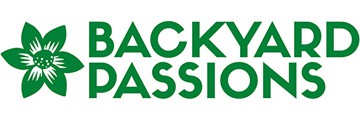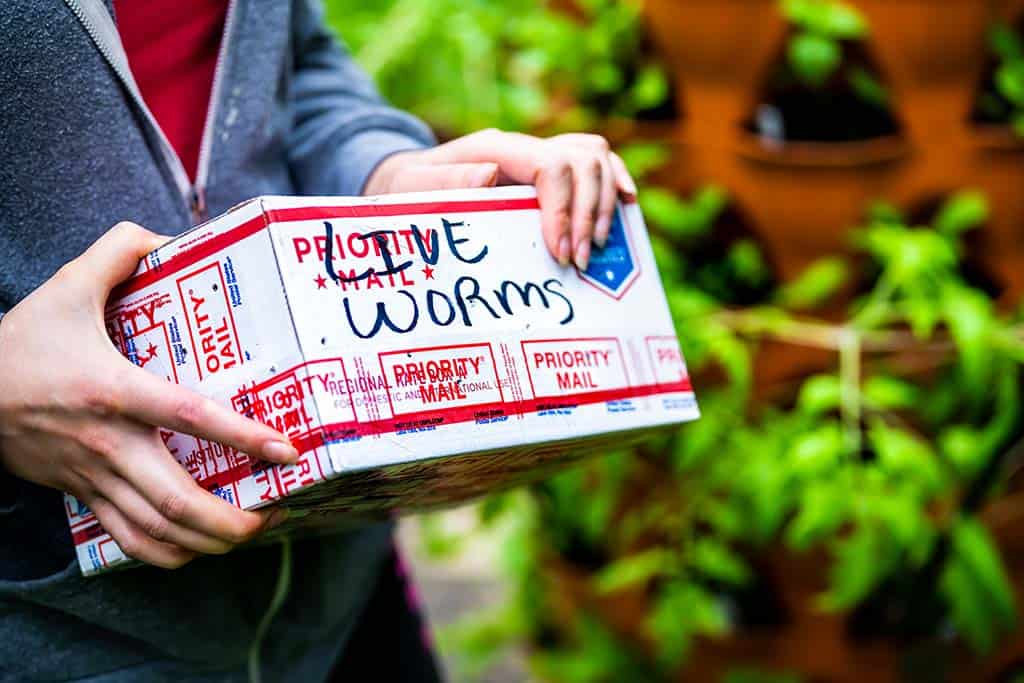Worm composting is one of the best ways to get rid of kitchen scraps. Not only do you get rid of kitchen waste, but you are rewarded with rich dark compost you can use in gardening.
But when I started my first worm composting bin, I discovered that not all worms make ideal composters. My first bin failed because I thought all worms were alike. But that’s not so. Not only are there different species of worms, but those species live in different parts of the soil. If you’re interested, I share those details later in this post.
After initially failing at worm composting, I learned that I couldn’t just dig up worms from my backyard. I needed worms that were epigeics. That’s not a species but describes their habit of being surface feeders. By digging in my yard, I collected burrowing worms, which are completely the wrong type for worm composting.
What I eventually discovered is that if you live somewhere with a temperate climate, there are two composting worms that have been shown to do well.
The two best composting worms are Eisenia fetida (Red Wiggler) and Eisenia hortensis (European Night Crawler). Red Wigglers grow quickly and tolerate temperatures up to 90°F. European Night Crawlers, although less prolific, tolerate colder and wetter conditions.
But if you live in a warmer climate, you can swap out the European Night Crawlers for their heat-loving cousins, the African Night Crawlers, which do well when it is warm but struggle under cool conditions.
I’ll go into more detail in this article and explain what exactly I considered in choosing my ideal composting worms.
What Makes an Ideal Composting Worm?
By reading the previous section you already know that an ideal composting worm should be one of the Epigeics, or Surface Feeding worms.
Although these worms tend to be smaller, they like to feed on large amounts of freshly decaying organic material, which describes kitchen food waste well.
But besides liking relatively fresh food, the ideal composting worm should have a few more useful characteristics. These are as follows.
- Thrives in a worm bin – First, it needs to be reasonably content to live out its entire life cycle in the confines of a composting bin or wormery. So, they need to be content to live together with other worms and not have a habit of trying to escape.
- Be tolerant of handling – Like it or not, you will have to handle the worms to some degree. For now, you might not like the idea of touching and handling worms but imagine what it’s like for the worms. For all they know, you could be a predator about to eat them. So, we need a worm that is not be unduly stressed by being disturbed and handled.
- Grow and reproduce quickly – It would be better if we could find a worm that can reach sexual maturity quickly and then produce a lot of offspring in a short space of time. This means we can start a worm bin with relatively few worms that will rapidly build up in numbers and start producing lots of vermicompost (worm castings or compost).
- Be an efficient composter – Not only do we want the number of worms in the bin to grow, but we also need them to have healthy appetites. But there’s a caveat, they shouldn’t turn all that food into body mass. They must be able to transform substantial amounts of organic waste into worm casts, which is our vermicompost.
Knowing these worm characteristics was only part of the battle is choosing the right worms. As I mentioned earlier, I also needed to know more about the different types of earthworms. I was then able to decide which species would be the best composting worm for me.
What is an Earthworm?
When I originally thought of worms, I had the image of the humble earthworm in my mind.
However, “Earthworm” is a generic term for worms that have segmented bodies and like to burrow. What’s more, there are many species of earthworm, and although I found it difficult to tell some apart, they are not all the same.
Anyway, I found there are basically three groups (not species) of earthworm. These groups have nothing to do with how the worms look but are related to their behavior or habits, specifically, where they like to live in the soil.
There are the Epigeics, or Surface Feeders, which like to consume freshly decaying plant and animal material at the soil surface. They tend to be small, thrive below the carpet of leaves under deciduous trees, or in compost, dung, and manure. They reach sexual maturity quickly and produce large numbers of offspring.
Then there are the Endogeics, or shallow living worms. These are medium-sized and live about 4 to 6 inches below the surface. Unlike the surface feeders, these worms mostly eat soil and some organic material around plant roots, but not the roots themselves.
Finally, there are the Anecics, usually large and deep living worms. In fact, they can burrow down as deep as 10ft. They’ll come up to the surface at night for decaying material that they can pull down into their burrow. Although can live long they do not reproduce quickly.
What Worms Are Best for Compost Bins?
Knowing the ideal worm composting characteristics and the habits of the three main groups of worms, it’s clear that it’s the surface feeders or epgeic worms, that I needed to concentrate on.
Fortunately, I’m not going to list every type of surface-feeding worm that I came across. Instead, I’ll introduce the four most often used composting worms in the US and Europe.
Red Wigglers are by far the number one choice for most worm composters, irrespective of latitude. However, European Night Crawlers will cope in cooler climates but are not as tolerant of heat.
If you happen to live where heat is an issue, say the southern parts of the United States or Australia, you may want to consider the African Night Crawler. They easily cope with higher temperatures but even they have their limits.
So let me introduce you to the composting worms I have found to be the best choice.
Red Wigglers (Eisenia Fetida)
This is a medium sized worm with a purple-pink banding or stripes. It’s also known as a brandling worm, tiger worm, manure worm, panfish worm and trout worm.
Of the three composting worms it’s the red wiggler that seems to be the most popular. They like food that has already started to decay. So, it’s no surprise that you’ll find red wigglers feasting deep in woodland decaying leave mould and compost or manure.
You’ll probably find many red wigglers together, and indeed they will tolerate communal living in the confines of a worm bin.
They naturally forage on a range of organic waste matter, will tolerate a wide range of temperatures and moisture levels, although they thrive best in a temperate climate. They don’t seem to be too bothered by being handled, and if given good conditions they are fast growers and will reproduce quickly. So, you could see your population of red wigglers doubling in about 90 days.
All these traits make red wigglers a popular choice for worm farmers.
Red Tiger Worms (Eisenia andreia)
This worm is like the Red Wiggler, except that it is darker in color, and the stripes are much less pronounced. Some people even describe this worm as being almost uniformly reddish. In fact, this worm and the Red Wiggler are so similar that previously it was thought to be just a color variant of the Red Wiggler.
Since these worms are so difficult to tell apart, breeders frequently treat them as the same, since it would take far too long to separate them. That’s why you may find E. andreia sold as Tiger worms. Don’t worry if you find that to be the case, the result will be just the same as if you were using true Red Wigglers.
European Night Crawler (Eisenia hortensis)
You’ll find the European nightcrawler by its Latin name of Eisenia hortensis, but in older reference work it was previously known as Dendrobaena veneta.
It’s a medium-sized worm that likes deep woodland leaf litter or soils that are rich in organic matter. You’ll normally see it as pink-gray in color, but if it hasn’t been feeding it will appear more pinkish. What will help you in spotting these worms is the cream or pale-yellow tip to their tail.
The European Night Crawler is larger than the Red Wiggler but has a much lower growth and reproductive rate. The species also tolerates damper and cooler conditions. Although it is usually outperformed by Red Wigglers, it can also be a good composting worm, especially if you also want to raise some bait worm for fishing.
Some people mix European Night Crawlers and Red Wigglers in the same bin. The system works but you may find the European Night Crawlers migrate to the bottom of the bedding, where it is damper.
African Night Crawlers (Eudrilus eugeniae)
The popularity of African Night Crawlers has been growing with worm composters who live in warm regions since they have big appetites and reproduce and grow quickly. But they don’t do well in cooler climates.
African Night Crawlers are gray and purple in color and can reach about eight inches in size. When kept under ideal conditions they are said to eat almost their own body weight of food every day. So, if you want to process a lot of food waste quickly, these may be the worm species for you!
The worms reproduce quickly too: they become sexually mature in about five weeks after hatching. They can produce an average of 3.5 cocoons each week, with typically 2 baby worms emerging from each cocoon. However, their environment greatly influences reproduction rates.
African Night Crawlers are native to the warm regions of Africa. So, it is no surprise that they thrive when kept at a temperature of 70°F to 85°F. It’s also reported that they will tolerate temperatures of 90°F, but such elevated temperatures are not recommended. Below about 60°F African Night Crawlers do not do very well at all and may die. So, don’t try keeping them if you live in cooler climates unless you are prepared to bring the worm bin indoors.
Summary
If you are just starting out with worm composting, you would be wise to follow what I figured out the hard way. Don’t try digging for worms in your backyard. It’s hard work and time-consuming, and when you have finally found your worms, you’ll too few and they’re likely to be the wrong kind. You need surface feeding worms, like Red Wigglers, which will quickly process your kitchen scraps into vermicompost. The other two popular types of worms for vermicomposting are European Night Crawlers and African Night Crawlers. The type you choose will depend on your climate or whether you are happy to bring your worm bin indoors for the colder months. Red Wigglers work in most areas. In cooler regions, you can use European Night Crawlers, but in warmer areas, African Night Crawlers might suit you better.


